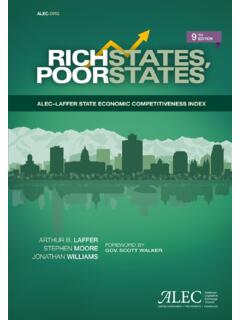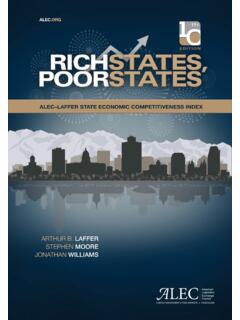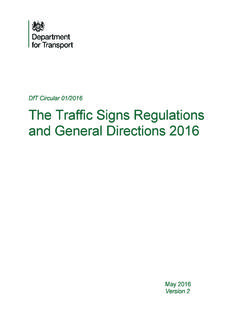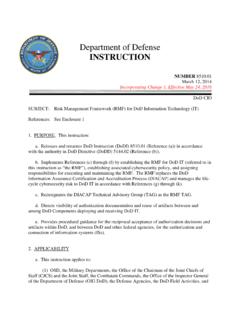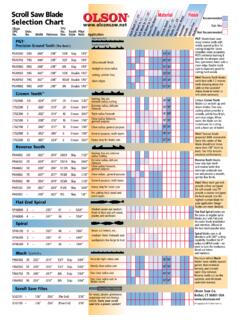Transcription of Federalism, Dillon Rule and Home Rule
1 WHITE. JA N UA RY 2016. PAPER. A PUBLIC AT ION OF T H E AM ER IC AN C IT Y COUNT Y EXCHA NGE. Federalism, Dillon Rule and Home Rule By Honorable Jon D. Russell & Aaron Bostrom Introduction I n recent years, there has been a rise in local governments using what little leverage they have in their states to pro- divisions. States use the Dillon Rule and Home Rule as ways to keep local governments focused on what they do best. As a re- mote policies that have traditionally been legislated in the sult, the state is able to maintain a limited local government to state capitals. Many of these local governments have seen their promote economic continuity throughout its borders. Whether attempts thwarted by their state legislatures with preemption a local government is governed by the Dillon Rule or Home Rule, and legal challenges. A careful study of local government re- the ultimate decision of what powers they possess resides with veals that while their attempts at legislating big policy issues the states.
2 May be well-intentioned, they are not staying true to the spirit of the law that governs them. Local governments across America follow one of two types of To learn more about how the American City governing authority: Home Rule or the Dillon Rule. Home Rule, County Exchange helps to advance limited as it sounds, gives local governments governing authority to government and free market principles in make a wide range of legislative decisions that have not been local government through model policies, addressed by the state. By contrast, the Dillon Rule creates a conferences and online collaboration. framework where local governments can only legislate what the state government has decreed. Both forms of governing author- American City County Exchange ity were created by the states to help carry out the mission of 2900 Crystal Drive, Suite 600. the states at a local level. It would be virtually impossible for Arlington, VA 22202. state governments to administer public safety, infrastructure Tel: and zoning issues without the creation of these political sub- Fax: W H I T E PA P E R.
3 What is the Dillon Rule? The Founding Fathers of the United States had a clear vision of how they intended government to work using a system of fed- eralism. By outlining this vision in the Constitution and the Fed- eralist Papers, the Founding Fathers hoped their design would allow each level of government to function properly and pro- vide stability to the country. Since the country's founding how- ever, the federal, state and local governments have competed for power and federalism has waned as the governing system. The Dillon Rule originated in the Iowa Supreme Court, of which Dillon did not regard local governments as equal or separate Justice John Dillon was a member from 1869 to 1879. In the from state government, but rather as political subdivisions of opinion of City of Clinton v. Cedar Rapids and the Missouri River the state. Rail Road Company, Justice Dillon spelled out the terms of his municipal philosophy: The Dillon Rule was later echoed by the United States Supreme Court in Hunter v.
4 Pittsburgh, 207 161, (1907), Municipal A municipal corporation possesses and can exercise the corporations owe their origin to, and derive their powers and following powers and no others: First, those granted in rights wholly from, the legislature. It breathes into them the express words (from the state); second, those necessari- breath of life, without which it cannot exist. 2. ly implied or necessarily incident to the powers expressly granted; third, those absolutely essential to the declared Created by the state, local governments exist to perform the objects and purposes of the corporation-not simply con- tasks of the state at the local level. Typically, the state issues venient, but indispensable; and fourth, any fair doubt as to an enabling statute, which entrusts the local government with the existence of a power is resolved by the courts against state power within a defined scope to achieve local objectives. the corporation. 1. Since the local government's power is derived from the state, the local government is strictly limited to what the state del- egates to it.
5 If local government supersedes the authority it is given, the state has the power to modify or revoke its powers. Ultimately under the Dillon Rule, local governments are tenants of the state. Federalism Understood The Dillon Rule is consistent with the principles of federalism and the Constitution. The Founders designed the federal gov- ernment to be dependent on the states, while the states could stand on their own. John Madison explained, Each of the prin- cipal branches of the federal government will owe its existence The Dillon Rule is consistent with the more or less to the favor of the State governments, and must principles of federalism and the Constitution. consequently feel a dependence. 3. The Founders designed the federal After the American Revolution, the states understood they government to be dependent on the states, needed some sort of federal government to link them togeth- while the states could stand on their own. er. James Madison wrote, Among the numerous advantages promised by a well-constructed Union, none deserves to be 2 AMERICAN CITY COUNTY EXCHANGE.
6 FEDERALISM, Dillon RULE AND HOME RULE. more accurately developed than its tendency to break and con- the several States will extend to all the objects which, in the trol the violence of faction. 4 The Union, designed by the Found- ordinary course of affairs concern the lives, liberties, and prop- ers, allowed the states to come together and endure difficult erties of the people, and the internal order, improvement, and times like the Civil War and the Great Depression. In addition prosperity of the State. 6 By dispersing power across the states, to preventing division, the Founders knew that they would be the Founders hoped to prevent the abuse of federal power: It better off domestically and internationally with more land, re- would tend to render the government of the Union too power- sources and manpower, sharing a common market and military ful, and enable it to absorb those residuary authorities, which between states. Hence the Founders created the federal gov- it might be judged proper to leave with the States for local pur- ernment and prescribed it to regulate interstate commerce and poses.
7 7 Local governments are simply extensions of the state, provide a military and navy, among other powers. Yet, for all created to deal with issues on the local level, which is exactly the importance of the federal government, it is the states that what the Dillon Rule stipulates. provide the unique counterbalance enabling the system of fed- eralism to work. Aside from preventing the tyranny of federal government, the Founders also understood that a government closest to the peo- Knowing the importance of unity, the states ceded some of their ple would best serve the people. Alexander Hamilton explained, power to the federal government in order to bring it into being. Just as the federal government is needed to unify the states, It is a known fact in human nature, that its affections are the states are necessary to prevent the tyranny of the federal commonly weak in proportion to the distance or diffusive- government over the people. The states also keep the feder- ness of the object.
8 Upon the same principle that a man al government in check by limiting it to its expressed powers. is more attached to his family than to his neighborhood, Essentially, the federal government's legislative powers consist to his neighborhood than to the community at large, the of those listed in Article One, Section Eight of the Constitution. people of each State are apt to feel a stronger bias towards Likewise, the judicial and executive branches are also confined their local governments than towards the government of to their enumerated powers listed in the Constitution. Alterna- the Union. 8. tively, the states retained their power in all areas and to the de- gree not enumerated or detailed. The Tenth Amendment of the Not only would state leaders care more about their state, but Constitution reads, The powers not delegated to the United they would also possess more knowledge on local issues. In States by the Constitution, nor prohibited by it to the states, are this way, the Founders envisioned that competent and invest- reserved to the states respectively, or to the people.
9 There- 5. ed leaders would more efficiently run their respective states fore, while the federal government's powers consist of an enu- and jurisdictions. merated few, state powers are both numerous and indefinite. Where are the Locals? The Founders made no mention of local government in the Constitution. This necessarily implies that local governments are creations of state governments under the authority of their state constitutions. While local governments play an important role in states, it is unfounded for local jurisdictions to contend they are equal to the states. The question remaining is whether local government was created by federal or state government. Since the federal government's responsibilities are limited to their enumerated powers, which make no mention of munic- ipal or county government, local government must belong to the states and the people inside them. James Madison touch- es upon this in Federalist Paper 45: The powers reserved to WHITE PAPER 3.
10 W H I T E PA P E R. Benefits of the Dillon Rule the Dillon Rule most strictly, was ranked Converse- ly, in a 2008 study done by Wolman, only one of nine states Although the relationship between state and local governments rejecting the Dillon Rule registered in the top ten for great- is a hierarchical one, it is not in the interest of the state to tie the est local government autonomy , while six of the remaining hands of local government. State governments want to bring eight found themselves outside the top As the data economic growth and prosperity to the entire state; therefore it show, there is no substantial link between the Dillon Rule and is rational for the state to allocate the proper amount of author- less local authority. ity to local governments that will enable them to operate most effectively. States that observe the Dillon Rule delegate power The Dillon Rule Guards Against Runaway to local governments to oversee zoning, planning, parts of tax- Local Governments ation and other areas where government closest to the people The Dillon Rule grants state government the power to rein in is most effective.
